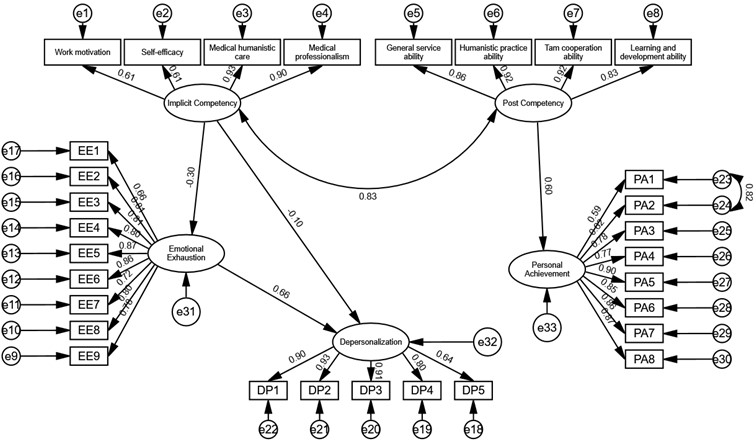Implicit Competency And Its Relationship With Post Competency And Job Burnout Among General Practitioners In Primary Healthcare In Chongqing: Analysis Using Structural Equation Modelling
Abstract
The National Health Commission emphasises the pivotal role of general practitioners in primary medical care and importance of training their competencies to enhance the quality of primary medical services and alleviate job burnout. Most current research focuses on post competency, whereas implicit competency and the correlations between implicit competency, post competency, and job burnout have not received sufficient attention. This study investigated implicit competency among grassroots general practitioners in Chongqing, China, and explored the relationship between implicit competency, post competency, and job burnout. This study aimed to provide a reference for the competency training of general practitioners. A questionnaire survey was conducted with 473 general practitioners in primary medical and healthcare institutions in Chongqing from January 2024 to February 2024, with participants selected using convenience sampling. Implicit competency, post competency, and job burnout scales were used. A structural equation model was used to analyse the relationships between implicit competency, job competency, and job burnout. The results indicated that only overall implicit competency was barely good (mean score = 4.08). Significant differences were observed in implicit competency scores by age, years of work, education, title, marital status, and workplace (P < 0.05). Significant correlations were found among the dimensions of implicit competency, post competency, and job burnout. Implicit competency and post competency were positively correlated (P < 0.05). Implicit competency had a significant negative effect on the emotional exhaustion and depersonalisation dimensions of job burnout (P < 0.05). Post competency had a significant positive effect on the personal achievement dimension of job burnout (P < 0.05). The implicit competency of grassroots general practitioners in Chongqing is inadequate. Implicit competency and post competency were positively correlated and had a negative impact on job burnout. It is crucial to enhance the implicit and post competence of general practitioners, as well as to reduce job burnout at the levels of general practitioners, medical institutions, and national policies for the construction of a general practitioner team and the implementation of a hierarchical diagnosis and treatment system.
References
[2] McClelland, D. C. (1973). Testing for competence rather than for "intelligence". American Psychologist, 28(1), 1–14. https://doi.org/10.1037/h0034092
[3] Wang, P., Ma, Z., & Li, Z. (2022). Research on improvement path of general practitioner competency based on implicit competency model. Soft Science of Health, 36(7), 49–55.
[4] Epstein, R. M., & Hundert, E. M. (2002). Defining and assessing professional competence. JAMA, 287(2), 226–235. https://doi.org/10.1001/jama.287.2.226
[5] Wei, Y., et al. (2021). Development and preliminary validation of the competency model for rural general practitioner in China. Family Practice, 38(3), 346–352. https://doi.org/10.1093/fampra/cmaa112
[6] Xu, L., Wang, Z., Li, Z., Lin, Y., Wang, J., Wu, Y., & Tang, J. (2022). Mediation role of work motivation and job satisfaction between work-related basic need satisfaction and work engagement among doctors in China: A cross-sectional study. BMJ Open, 12(10), e060599. https://doi.org/10.1136/bmjopen-2021-060599
[7] Tian, Y., Ma, H., & Meng, J. (2023). The influence of community workers' sense of organizational support on job stability in some townships of Shanxi Province: A double-chain intermediary between job burnout and job satisfaction. Chinese Journal of Health Statistics, 40(6), 905–909.
[8] Wang, J.-L., Yu, Q.-W., Huang, Z.-Y., et al. (2022). Occupational burnout of general practitioners and Balint group work. Chinese Community Doctors, 38(10), 162–164.
[9] Maslach, C., & Leiter, M. P. (2016). Understanding the burnout experience: Recent research and its implications for psychiatry. World Psychiatry, 15(2), 103–111. https://doi.org/10.1002/wps.20311
[10] Huang, L., Dai, J., Zhang, H., et al. (2013). Association between job burnout and health-related productivity loss among medical staff. Environmental and Occupational Medicine, 30(5), 321–327. https://doi.org/10.13213/j.cnki.jeom.2013.05.018
[11] Ma, Z., Wang, P., & Pan, H. (2023). Development, reliability and validity of the General Practitioner Inner Competency Rating Scale. Chinese General Practice, 26(4), 467–476.
[12] Ma, Z., Zhang, B., & Guo, L. (2023). Development, reliability and validity of the General Practitioner Competency Rating Scale for assessing general practitioners' competencies in delivering contracted healthcare services. Chinese General Practice, 26(4), 477–485.
[13] Li, C.-P., Shi, K., Luo, Z.-X., et al. (2003). An investigation on job burnout of doctor and nurse. Chinese Journal of Clinical Psychology, 11(3), 170–172.
[14] Gan, Y., Jiang, H., Li, L., Yang, Y., Wang, C., Liu, J., Yang, T., Opoku, S., Hu, S., Xu, H., Herath, C., Chang, Y., Fang, P., & Lu, Z. (2019). Prevalence of burnout and associated factors among general practitioners in Hubei, China: A cross-sectional study. BMC Public Health, 19(1), 1607. https://doi.org/10.1186/s12889-019-7755-4
[15] Wang, G., & Wang, Y. (2012). Discussion on the normalization method of attribute value in MADM. Statistics & Decision, 28(20), 20–22.
[16] Yao, H., Tian, K., Zhong, X., et al. (2011). Influencing factors on behavior related to HIV testing among female commercial sex workers based on the structural equation model. Chinese Journal of Epidemiology, 32(11), 1158–1161. https://doi.org/10.3760/cma.j.issn.0254-6450.2011.11.023
[17] Hofer, J., & Busch, H. (2011). Satisfying one’s needs for competence and relatedness. Personality and Social Psychology Bulletin, 37(9), 1147–1158. https://doi.org/10.1177/0146167211405992
[18] Niu, A., Ma, H., Chen, Z., Zhu, X., & Luo, Y. (2023). Exploring the competencies of operating room nurses in mobile surgical teams based on the Onion Model: A qualitative study. BMC Nursing, 22(1), 254. https://doi.org/10.1186/s12912-023-01417-3
[19] Ma, Z., Guo, L., Li, Z., et al. (2023). Development of the general practitioner competency model using grounded theory for assessing general practitioners' competencies in delivering contracted care services. Chinese General Practice, 26(4), 460–466, 485.
[20] Xu, L., Wang, Z., Li, Z., Lin, Y., Wang, J., Wu, Y., & Tang, J. (2022). Mediation role of work motivation and job satisfaction between work-related basic need satisfaction and work engagement among doctors in China: A cross-sectional study. BMJ Open, 12(10), e060599. https://doi.org/10.1136/bmjopen-2021-060599
[21] Li, Y., Li, B., Zhang, Z., et al. (2023). Chain-mediating effect of emotional exhaustion and depersonalization between negative emotion and turnover intention among primary health workers. Chinese Journal of Public Health Management, 39(6), 802–806. https://doi.org/10.19568/j.cnki.23-1318.2023.06.0012
[22] Gan, Y., Gong, Y., Chen, Y., Cao, S., Li, L., Zhou, Y., Herath, C., Li, W., Song, X., Li, J., Yang, T., Yin, X., & Lu, Z. (2018). Turnover intention and related factors among general practitioners in Hubei, China: A cross-sectional study. BMC Family Practice, 19(1), 74. https://doi.org/10.1186/s12875-018-0752-3
[23] Wang, H., et al. (2020). Investigation and analysis of standardized training for residents of general practitioners of Gansu Province in China. BMC Family Practice, 21(1), 223. https://doi.org/10.1186/s12875-020-01299-1
[24] Su, Q., et al. (2023). Preparing future general practitioners: The effects of individual, familial, and institutional characteristics. BMC Medical Education, 23(1), 514. https://doi.org/10.1186/s12909-023-04512-8
[25] National Health Commission. (2021). China health statistical yearbook 2021. Beijing: China Union Medical College Press.
[26] Zhou, Y., Fang, L., Yu, D., et al. (2021). General practice department in China's general hospitals: Functions and development strategies. Chinese General Practice, 24(13), 1581–1584, 1591.
[27] Qin, H., et al. (2023). Follow-up survey of general practitioners in Zhejiang Province post-completion of position transition training in 2017–2020. BMC Medical Education, 23(1), 321. https://doi.org/10.1186/s12909-023-04287-w
[28] Chongqing Municipal Health Commission. (2022). Chongqing health statistical yearbook. Chongqing: China Statistics Press.
[29] Lampman, M. A., Chandrasekaran, A., Branda, M. E., Tumerman, M. D., Ward, P., Staats, B., Johnson, T., Giblon, R., Shah, N. D., & Rushlow, D. R. (2021). Optimizing huddle engagement through leadership and problem solving within primary care: Results from a cluster-randomized trial. Journal of General Internal Medicine, 36(8), 2292–2299. https://doi.org/10.1007/s11606-020-06487-6
[30] Jin, H., Yang, S., Zhou, H., et al. (2024). An empirical study on the application of leadership evaluation indicator system for managers in primary medical institutions. Chinese Journal of General Practitioners, 23(3), 237–243. https://doi.org/10.3760/cma.j.cn114798-20230914-00159
[31] Xin, R., Li, L., Qiaoli, S., Xingyue, W., & Shuangqing, L. (2022). Perspectives of general practitioners towards their supervisors over the past ten years in China. BMC Medical Education, 22(1), 415. https://doi.org/10.1186/s12909-022-03442-3
[32] Cheng, X., Shang, Y., & Han, Y. (2023). General practice in China: Status and challenges. Academic Journal of Naval Medical University, 44(7), 773–777. https://doi.org/10.16781/j.CN31-2187/R.20220737
[33] Deng, J., et al. (2023). The relationship between psychological capital, patient’s contempt, and professional identity among general practitioners during COVID-19 in Chongqing, China. Plos One, 18(10), e0293164. https://doi.org/10.1371/journal.pone.0293164
[34] Cheng, Z., et al. (2020). Research on the status quo and influencing factors of community general practitioners’ competency in Chongqing. Medicine and Society, 33(9), 72–76. https://doi.org/10.13723/j.yxysh.2020.09.016
[35] Ministry of Education. (2024, January 2). Response to Recommendation No. 6214 of the First Session of the 14th National People's Congress. Retrieved March 21, 2024, from http://www.moe.gov.cn/jyb_xxgk/xxgk_jyta/jyta_zcs/202401/t20240102_1097490.html
[36] Ministry of Education. (2021, October 9). Response to Recommendation No. 5708 of the Fourth Session of the 13th National People's Congress. Retrieved November 21, 2023, from http://www.moe.gov.cn/jyb_xxgk/xxgk_jyta/jyta_xueshengsi/202209/t20220923_664155.html
[37] Tang, L., Yang, H., Mao, Z., Li, Q., & Li, S. (2022). The negative factors influencing the career intention of general practice trainees in eastern China: A qualitative study. BMC Medical Education, 22(1), 393. https://doi.org/10.1186/s12909-022-03456-x
[38] Li, L., Zhang, Z., Sun, Z., Zhou, H., Liu, X., Li, H., Fan, L., & Coyte, P. C. (2014). Relationships between actual and desired workplace characteristics and job satisfaction for community health workers in China: A cross-sectional study. BMC Family Practice, 15, 180. https://doi.org/10.1186/s12875-014-0180-y
[39] Assassi, S., et al. (2017). Associations of perceived social support and positive psychological resources with fatigue symptom in patients with rheumatoid arthritis. Plos One, 12(3), e0173293. https://doi.org/10.1371/journal.pone.0173293
[40] Wu, Y., et al. (2022). Research on current status of post competency of general practitioners in grassroots medical institutions in Chongqing. Medicine and Society, 35(5), 18–22+28.
[41] Stobbe, E. J., Groenewegen, P. P., & Schäfer, W. (2021). Job satisfaction of general practitioners: A cross-sectional survey in 34 countries. Human Resources for Health, 19(1), 57. https://doi.org/10.1186/s12960-021-00604-8
[42] Khan, U., et al. (2022). Needs assessment of general practitioners in Pakistan: A descriptive cross-sectional survey. Journal of Family Medicine and Primary Care, 11(12), 7602–7608. https://doi.org/10.4103/jfmpc.jfmpc_123_22
[43] Yang, H., Han, J., & Xu, Y. (2019). General practice workforce in China: Development, challenges and outlooks. Chinese General Practice, 22(19), 2267–2279.
[44] Cohidon, C., Wild, P., & Senn, N. (2019). Practice organization characteristics related to job satisfaction among general practitioners in 11 countries. The Annals of Family Medicine, 17(6), 510–517. https://doi.org/10.1370/afm.2449
[45] Xu, Y., Jia, H., Deng, J., et al. (2023). Training effect and influencing factors of job-transfer training for general practitioners in Chongqing province. Chinese Journal of General Practice, 21(8), 1402–1406. https://doi.org/10.16766/j.cnki.issn.1674-4152.003132
[46] Li, Y.-B., et al. (2013). Analyzing the satisfaction and responsiveness on the implementation of performance payment system of medical personnel in community health service institutions. Chinese Health Service Management, 30(3), 172–175+215.
[47] National Health Commission. (2024, March 27). Transcript of the press conference of the National Health Commission on 27 March 2024. Retrieved from http://www.nhc.gov.cn/xcs/s3574/202403/023cc0c823c64c2d99f73981578be07f.shtml
[48] Hangzhou Lin’an District People’s Government. (2024, January 29). Work summary in 2023 and work ideas in 2024. Retrieved from https://www.linan.gov.cn/art/2024/1/29/art_1229231579_4236145.html


This work is licensed under a Creative Commons Attribution 4.0 International License.
Copyright for this article is retained by the author(s), with first publication rights granted to the journal.
This is an open-access article distributed under the terms and conditions of the Creative Commons Attribution license (http://creativecommons.org/licenses/by/4.0/).









1.png)














